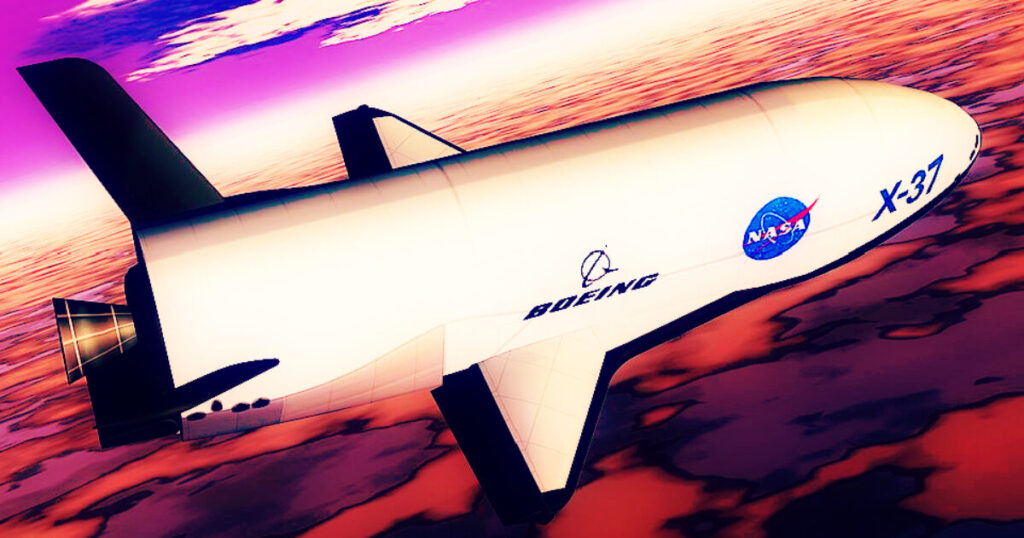The Boeing X-37B is a secretive and innovative robotic spacecraft developed for unique flight maneuvers that have not been attempted before. This reusable spaceplane is launched into space by a conventional launch vehicle and returns to Earth’s atmosphere for landing, offering a revolutionary approach to space exploration and technology testing. The origins of the X-37 project date back to 1999 when it was initially conceived by NASA. However, in 2004, the project was transitioned to the US Department of Defense, reflecting the increasing military focus on space operations and technologies. The X-37B is operated by the Department of the Air Force Rapid Capabilities Office in partnership with the United States Space Force, signifying a collaborative effort between these entities to explore advanced capabilities in orbit.
The central purpose of the X-37B revolves around conducting orbital spaceflight missions that showcase reusable space technologies. Although specific details regarding the mission objectives remain scarce, there have been indications of its strategic utility. For instance, an official illustration from the previous year depicted the X-37B in a scenario where it intercepts an adversary satellite, highlighting its potential role in safeguarding U.S. satellite operations. This aspect of the X-37B’s capabilities raises questions about its contribution to national security and the military’s broader objectives in space.
A notable element of the X-37B’s current mission involves a series of innovative maneuvers known as aerobraking. These maneuvers utilize Earth’s atmospheric drag to alter the spacecraft’s orbit while conserving fuel—a significant advantage for extended missions in space. This operational strategy is designed to efficiently manage the spacecraft, particularly as it aims to safely dispose of its service module components. Since December 2023, the Space Force has utilized the X-37B to conduct radiation effect experiments and evaluate Space Domain Awareness technologies while operating at a ‘Highly Elliptical Orbit’. This approach underscores the multifaceted objectives of the X-37B, from testing advanced technologies to contributing to national defense.
Following the completion of the aerobraking maneuvers, the X-37B is expected to continue its operational testing and experimentation until all mission objectives are fulfilled. Upon completion of its tasks, the vehicle will de-orbit and return safely to Earth, mirroring the successful strategies employed during its previous six missions. This ability to seamlessly transition from orbit back to terrestrial operations is a testament to the advancements made in spaceflight and the X-37B’s innovative design.
Leadership from the Space Force has expressed strong support and enthusiasm for the X-37B program. Secretary of the Air Force Frank Kendall highlighted the significance of the aerobraking maneuvers as a demonstration of the Space Force’s commitment to pioneering innovative technologies that align with national security goals. Similarly, Chief of Space Operations Gen. Chance Saltzman praised the milestone achieved by the X-37B team, recognizing the importance of expanding the United States’ capabilities in what has become an increasingly competitive space domain. These leaders acknowledge that the success of this mission not only emphasizes the technical proficiency of the X-37B but also reaffirms the U.S. commitment to maintaining a strategic advantage in global space operations.
In conclusion, the Boeing X-37B serves as a groundbreaking vehicle, showcasing advanced space capabilities while fulfilling essential national security objectives. Its operations reflect a paradigm shift in how space missions are conceived and executed, particularly concerning the integration of military assets in orbit. The ongoing advancements demonstrated through the X-37B program underscore the broader implications for future space exploration, technological innovation, and the evolving landscape of military operations in space. The collaborative efforts among various defense entities reinforce the idea that the exploration of space is not only a scientific endeavor but also a crucial component of national strategy in safeguarding interests beyond Earth’s atmosphere.

